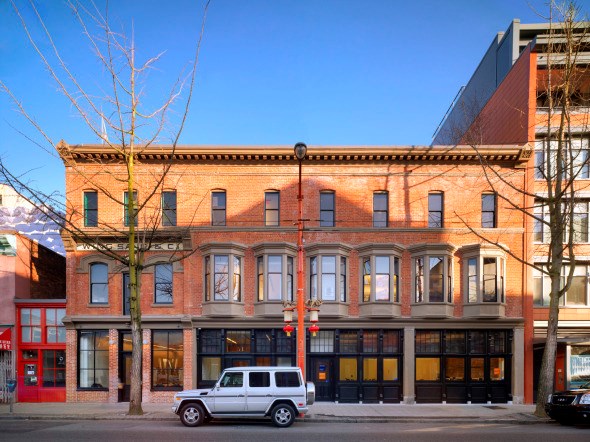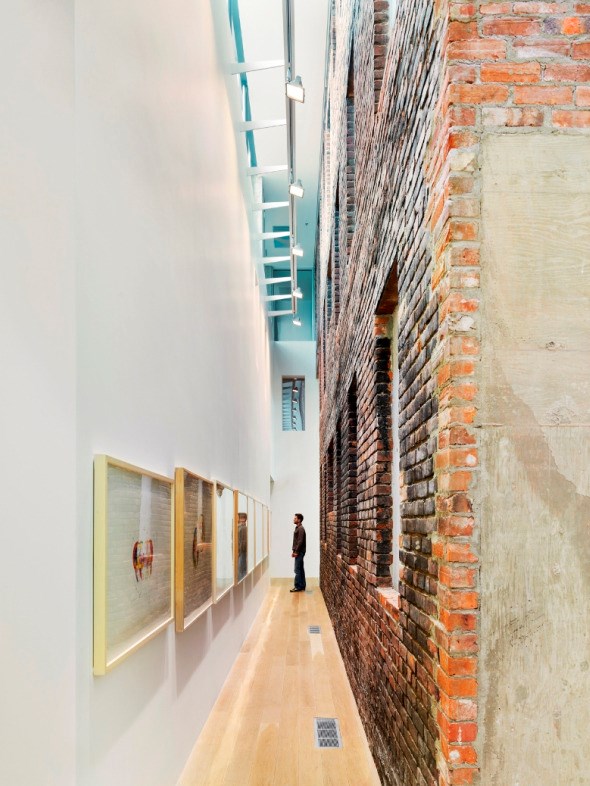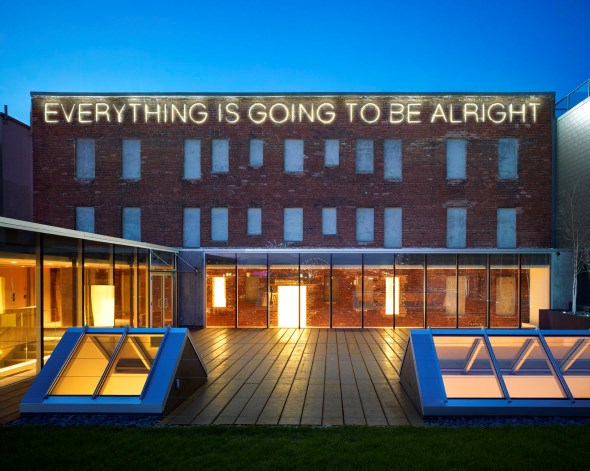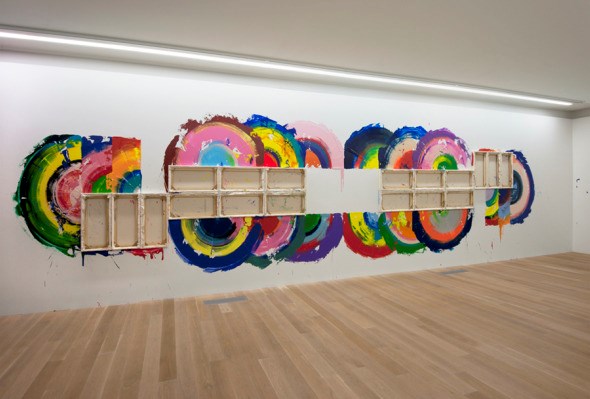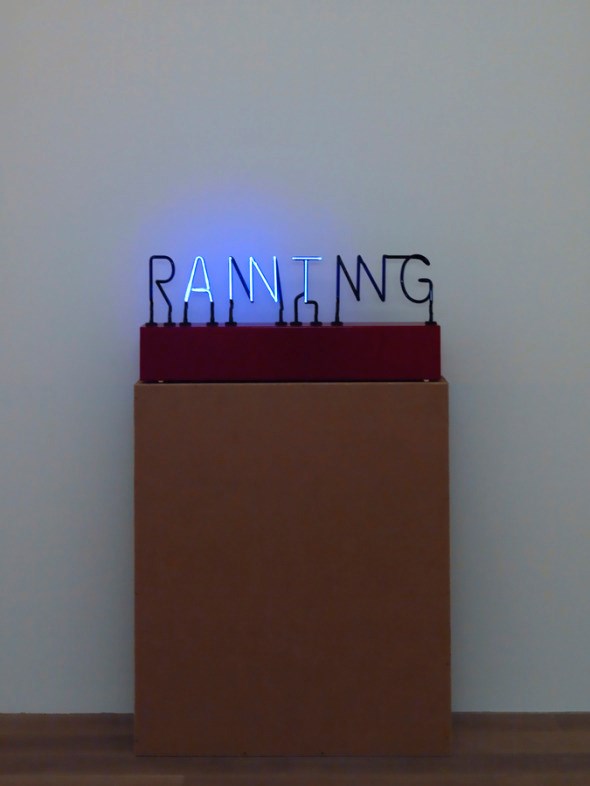Most Vancouverites know the Bob Rennie of Rennie Marketing Systems, the largest real estate marketing firm in town.
But do you know the Bob Rennie that happens to own the largest personal art collection in all of North America? Yeah, wow. The first piece of artwork Bob ever bought was a Norman Rockwell print at the age of 17, which goes to show he had a love for arts and culture right from the get-go. Both his new office headquarters and adjoining personal gallery in the historic Wing Sang Building call Chinatown home -- plus sometimes Bob gives gallery tours on Sundays and he has an Expo Ernie! -- all of which we think is totally, totally awesome. --May Globus
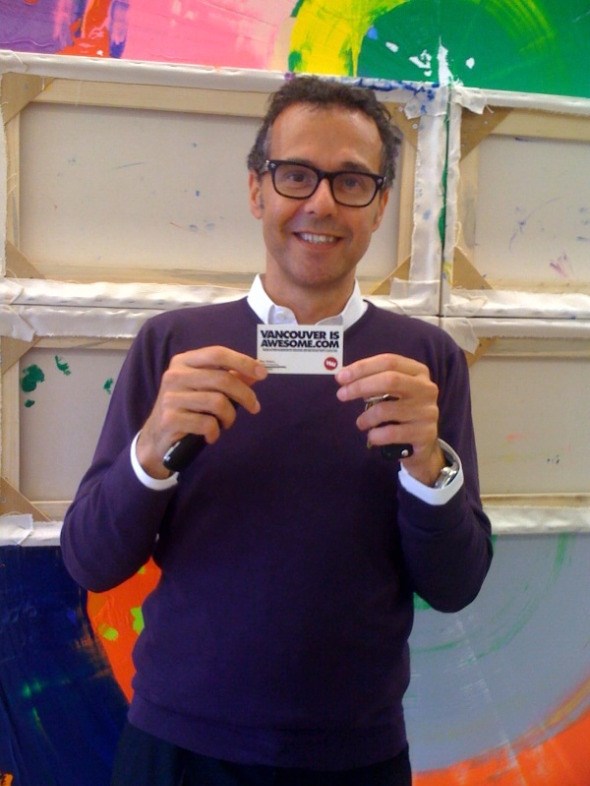
What neighbourhood did you grow up in and where do you live now?
I grew up in East Vancouver. Maybe that's why I have a comfort with the downtown eastside. Now I live just off Granville Island; it works out really central for us.
Why did you pick Chinatown for your new office and gallery?
The city has been good to me. I've sold real estate here for 35 years, and I want to help balance out the downtown eastside. I represented Woodwards for the developer, and I couldn't afford to [build the offices] on Granville or on Burrard, though probably after this I may as well have! I wanted something to balance off the art, and [since the Wing Sang Building] is the oldest building in Chinatown, it just seemed to be a really nice, civil fit for a museum to be housed, culture within culture.
I heard this building was four years in the making -- the Wing Sang was pretty derelict before the renovation.
Yeah, we bought it in 2004 and we moved in October of 2009. This part of the building was built in 1889, and this [other] part of the building was built in 1902. The back building was built in, I believe, 1908.
Back then, there was a curfew on the Chinese population after sundown, so there were these secret lane ways that ran through Chinatown, and there were also tunnels under the street to get across the street. We filled those in and had to restore the foundation, but part of our commitment to the heritage was to save the back building and all the outside walls. [For the most part], we tried to put back what was there. This was four floors of 48 rooms, and it was full of dead birds. It was awful. That took about three months to clear that out. We saved all the old beams from the back -- when we go through [the building], the floor, the offices and [some of the] furniture are made of 800-year-old wood.
Did you work with a local architecture firm?
Yes. Walter Francl is the building architect, and McFarlane Green Biggar are the interior architects. We've worked with Michelle Biggar for about five years -- we're really comfortable with [MGB].
I was looking at the photographs on the wall in your front waiting room. They're stunning.
There's no art allowed in the offices, save for mine. Scott Massey is the photographer who did the art project on the history and the restoration of the building -- that's all the way through the offices. We always try to keep church and state. We don't want people to confuse bad marketing with good art or great art with bad marketing.
You try to keep things exclusive.
Yes. Right now, we've got Richard Jackson up. There are about 170 artists in the collection, and there are 40 artists we collect in depth. Richard Jackson is one of them; he's an engineer and very, very structured. Our first show was Mona Hatoum, so Mona, a Palestinian artist, was really heavy and dealt with identity. Richard is 71-years-old and has influenced a lot of California artists -- he's important on the planet. He moved here most of the month of April to install, and it was something we thought we should do.
Who else are you bringing in here?
For the next show, we're showing Thomas Houseago and Amy Bessone, a sculptor and a painter. They've never shown together, but they are husband and wife; they're [also] two artists we collect in depth. From May, we're installing [the] British artist Martin Creed.
His "Everything Is Going To Be Alright" light installation is on your roof!
Yes! But he had another work that was very controversial; he had a team of runners running around through the Tate [separately in 30 second intervals] all day, [commenting] on why we spend so much time looking at art or moving sculpture and that's a work we own -- one wall is about a thousand pieces. We'll install about 30 works of Martin's.
Why did you decide to put Creed's "Everything Is Going To Be Alright" on the roof? Is there a special meaning for you?
We collect Martin in depth -- we have other neons works by him. There are three versions by him: the Tate has theirs up right now, the National Museum of Scotland has theirs up on loan from the Tate and we own ours. But we just thought it's controversial because of where we installed it, and it's controversial because of economic times, but I [also] think it makes people talk. With [the phrase] "Everything Is Going To Be Alright", [it's as if] we almost have no choice; whatever cards we're dealt, we need to deal with. Philosophically I believe in it, but it's just a very simplistic statement that Martin made, and it's really not that deep.
It's a little beacon of hope.
It is, and I think that people try to read a lot more into it. We didn't do a press release, we just put it up and thought, let's see how it breathes in the city as public art, so [now it's] installed as public art. In the gallery, we only show artists from the collection. We will never show art that isn't owned by the Rennie collection. You know, it's a tough word to say "never", but it's taken us 20 years to install the collection, so I've done this really quietly. I've collected serious pieces; I started in 1976.
Your first piece of artwork was a Norman Rockwell print, right?
I still have it! It's a boy and girl sitting. It [currently] sits in the warehouse. So the idea [of the Rennie Gallery] is to be a collecting museum and show our works.
In terms of local artists, are there any you feel are up and coming or that you keep an eye on?
After the end of 2011, we're going to show Damian Moppett, who has a show up right now at the Catriona Jeffries Gallery. We've worked with him for years. And there's Brian Jungen, a First Nations artist who cut up Nike runners and made them into masks. We collect Brian in depth. There's also Rodney Graham, who is also local. Ian Wallace, too, who has taught at UBC and was recently recognized for an award. We tend to watch artists for awhile. We also just brought Geoffrey Farmer into the collection, and we'll start to work with him. We're always watching, but I prefer to watch for a few shows to see where careers move. We don't care about the frenzy of being the first [to buy]. We really like to work with artists whose careers are developed [and are continuing to develop].
We have many galleries in town, big and small. Which ones do you feel are en pointe with whom they exhibit?
I have respect for so many galleries in town. I really have a relationship with Catriona [Jeffries] because she represents a number of artists that we collect, but it tends to be that the works [we have] are from gallery relationships around the planet -- it just happens that way. But I have friendships with a lot of galleries in town. I haven't been out to enough younger galleries in town, but I think it's time.
Yes, there's a couple: the LES Gallery, the Grace Gallery...
Someone told be about the Grace Gallery the other day. I work so hard in this city, it's [difficult] to get out and see [them], but when we get away from [working], then we get to spend that time.
You're a member of the North American Acquisitions Committee for the Tate Modern. How's that been going for you?
Yes, I'm chair of the North American Acquisitions Committee for the Tate -- I've sat on their board for five years and just became chair. It's good. My job is to change the way that the board is and to get a few more people on the board and [to make] more conference calls and [to do] more acquisitions. It sounds way bigger than it is, but for me, to spend time with the curators of the Tate is a huge privilege for what we do. And I think it brings a lot more people through town, too, which I think is healthy for Vancouver and certainly healthy for Chinatown. [The gallery] is open Tuesdays and Thursdays for tours, and they tell me the business in the neighbourhood spikes on those days, which is good.
Do you have a favorite piece of artwork in your arsenal?
You know, there's a photograph that I always say is one of my favorites in the collection, but it depends what part of the collection we're talking about. There's a collection on identity, prejudice and race; there's a sculpture collection and there's a painting collection. So it just depends where we're at at that minute. It wanders.
Socio-economic issues seem to be a major theme in the Rennie collection.
A part of the collection is; it's probably a third of the whole [thing]. And race and identity, too. And it just happened that [we have] a number of African-American artists, like Kerry James Marshall, for example, who is currently showing in town right now.
The great thing about having [an artist like] Richard Jackson install [works] is that we have a manual, that way when it goes back into storage and then lend it out [to museums], we have a proper manual.
So there are tours every Tuesdays and Thursdays by appointment?
Yes, on Tuesdays and Thursdays. Emily Carr students in curatorial studies work with us as interns, and they give tours. I prefer that people actually get an informed tour, so they come through with some guidance and explanation.
Do you think you'll ever leave the real estate business to concentrate on art full-time?
I think that I'm the luckiest guy the world because my career gives me the ability to do this. I think as long as I can keep building the collection and the museum, I would be crazy to ever stop working. But I tell my kids that, in the end, I really believe I want my legacy to be the museum. Real estate is wonderful, and I'm addicted to it and everyone lets me play in their sandbox, but this is something that I think adds to the fabric of the city.
There are lots of great things happening with the local art scene, like the opening of the W2 Community Media Arts Centre, but what can we do, in your opinion, as this city's citizens to promote local art more? And better?
You know, my thing is I think I can get intellect to move here, but it won't stay here unless we really grow up culturally. If, say, Bob does visual art and someone runs off into their corner for opera and someone does poetry reading and someone does dance and somebody does public sculpture and another does social media, if we all develop a lot of smaller venues where [this can happen], then the town just becomes alive. I don't think we need monstrous venues. That's not today's economy, and I think we've gone from unconscious to conscious.
When I walk down Blood Alley, I see Judas Goat -- it's tiny, but it's packed and busy and I go, wow. I think that's what's happening. [People like you] are going to decide the direction of this city. I'm an old guy. You're not demanding bigger and bigger and bigger. You're looking for little intimate adventures and discovery. I think that's what going to make this city. And I think the intellect that's moving here is going to insist on it, and they're going to get engaged. As locals, we just sit and watch it grow because we always want it to be like it used to be. But newcomers want it the way it should be tomorrow.
Saying you're a fairly busy man is a massive understatement. Where in the city do you go to clear your head?
I get up at 4:30am seven days a week, so I'm not really a night person. More and more, we bike ride to be healthy, though!
What's your favorite restaurant?
I like Aphrodite Cafe on West 4th. It's organic.
Oh, the cafe that makes all those pies...
Yes, they have lots of pies!
You have an Expo Ernie, too, I see.
I actually did a talk at the Urban Development Institute the other day and brought him with me. The young artist Jeremy Shaw, who did those recent Expo posters, put a plexiglass case around it, making it into a piece of art. At one time, we thought that was the future. Jeremy is a local artist we follow; he's living in Berlin now with his band, Circlesquare.
What makes Vancouver so awesome?
You know, everybody gets mad when I say we're a world-class city, but what world-class city [really] means is that you're different -- you're not the same as everyone else. I think that people think world-class means the same as other major cities. We're not Paris, we're not London, we're not L.A., we're not New York and we're not Tokyo. We're Vancouver. People come here.
[Sometimes] you can't describe why you're in love with a city -- you can't [always] describe why you love somebody -- it's just sort of that the sum of the whole is far greater than the sum of its parts. And that's what Vancouver is. You can't [quite] pinpoint it, but you know you want to come back. You say, I want to live there. And there are not many places on the planet that so many people want to live [like they do Vancouver]. And I think as locals, we just don't understand it. We do not understand how comfortable people are being in Vancouver. Everything we say we don't have is one of the reasons why people really like being here. I watch the world come here, and they want to stay.
But I think it's that indescribable difference that makes us so awesome.
Thanks for your time, Bob!
* All photos by Martin Tessler and Site Photography
